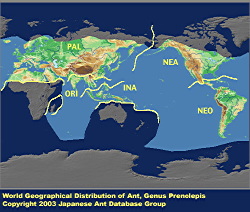
|
genus
|
Prenolepis
|
 |
Japanese Name
|
Uwame-ari-zoku
|
Original Reference
|
|
Mayr, G. (1861) Die EuropŠischen Formiciden. (Ameisen.): 80 pp. Wien.
|
Description
|
|
Small to medium-sized ants: total length of workers about 2 - 6.5 mm. Size and body color similar to ants of the genus Paratrechina; antennal scapes long, like many Paratrechina species. Differing from Paratrechina as follows: Eyes situated behind the midlength of head. Standing hairs absent, but long, inclined pubescence is densely present on the antennal scapes and tibiae. Mesosoma as a whole dumbbell-shaped in dorsal view: prothorax and propodeum wide and globular; mesothorax narrow, its width less than half the prothoracic width. Palpal formula 6:4. Males have cerci.
|
|

|
Remarks
|
|
Prenolepis was established by Mayr in 1861 and, until Emery revised the subfamily Formicinae in 1925, the genus contained many species now assigned to Paratrechina. Indeed, most species originally described in Prenolepis now belong in Paratrechina. The Oriental species allocated to these genera remain generally unrevised. Only the North American species P. imparis (Say) has been surveyed ecologically. It generally nests directly in the soil. The main food is liquid obtained from plants and aphids, and the workers often have swollen gasters. P. imparis is notable for its low-temperature activity, even at a few degrees above freezing (Creighton, 1950). Around ten Prenolepis species are distributed in southeastern Europe and Asia, and one in North America. A single nomenclaturally undetermined species is present in Japan.
|
References
|
|
- Mayr , 1861
- Emery, C. (1925). Hymenoptera, Formicidae, Formicinae. . In M. P. Wytsman, ed., ""Genera Insectorum"", fasc. , 183, 1-302.
- Creighton, W. S. (1950). The ants of North America. . Bull. Mus. Comp. Zool. Harvard, 104, 1-585, 57 pls.
|
Editor
|
|
Original text by Masaaki Morisita and Keiichi Onoyama. English translation by Keiichi Onoyama, edited by Robert W. Taylor.
|
|